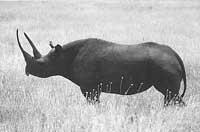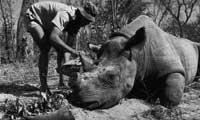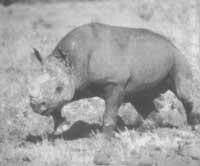Problems of conservationism: the case of rhino
1992/05/01 Larrañaga, Jon Iturria: Elhuyar aldizkaria
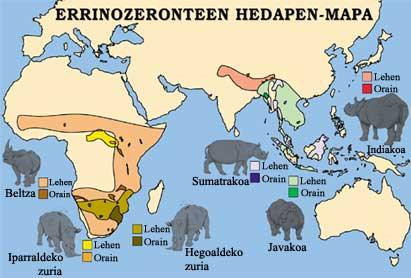
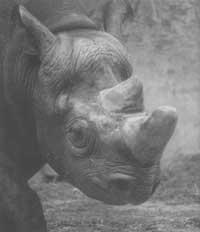
Although the pressure of hunting has been exercised by all species of rhinos, the case of black rhino is undoubtedly the most obvious example of the strong impact of this action. According to the estimates made by conservationists, the decrease experienced by this species in the last twenty years is estimated between 95 and 98%, being the current population of 3,500 individuals. For example, if in the 1960s it had 20,000 black rhinos, by the end of 1970 the figure did not reach 300 individuals. Moreover, it is estimated that between 1970 and 1987 a total of 40,000 rhinos were hunted, reaching 100 tons of branches sold in the international market.
On the other hand, although the impact of hunting is always worrying, in some cases it can be affirmed that the situation has become very serious. The 60 rhinos of the species Java, the 700 of the sumatra and the 42 of the northern white are in danger of extinction and if the poaching is not prevented, the XXI. the destruction of the twentieth century can become reality.
Market of rhino branches
When analyzing the causes of hunting it is essential to mention the importance of the black market of rhino branches. Market prices for these branches have increased since the 1970s, a million pesetas per kilo of the African branch, and 5 million pesetas per kilo of the Asian branch. Although African hunters only receive a small part of these coins, the profit they obtain with a single branch is equivalent to the entire year's salary. Therefore, it is not surprising that they face the risk of being detained (especially in cases where the penalty is a fine or a brief jail term) and even less when, due to the necessary fortune, the number of caregivers in many protected areas is less than due.
However, when governments have decided to seriously protect rhinos (such as the governments of Kenya, Zinbabue or Nepal) and have put all the necessary means and vigilantes for it, it has been seen that poaching has decreased considerably.
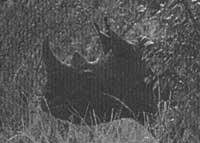
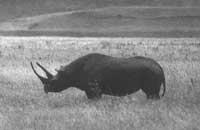
Although it was initially considered that most of these branches went to the Chinese market and that in it they were used as aphrodisiacs, today, the World Wildlife Fund (W. F.V.) As a result of the research carried out by the North American geographer Esmond Bradley Martin, of the conservation society, we know that for this purpose it is only used in India (where only 1% of the number of branches is consumed) and that it is not China, but the Arab republic of Jemen, main consumer of the rhino branches, which imported 1,500 kg annually in the 1980s.
The men of the area usually carry in the belt a dagger that symbolizes humanity and the social level, being the most appreciated those who have an environment of rhino horns. In the 1970s, when the oil boom raised the living standards of the Jemendes, the same happened with the demand for rhino horns, consuming from 1971 to 1977 22 tons of branches (40% of the world market).
However, the introduction of other materials in the manufacture of tours in recent years, the decline in the economy of Jemen and, above all, its West, have caused that the demand of this product has diminished considerably.
However, the Chinese market is still important. In traditional local medicine, rhino products have been used at least in the last 2,000 years (mainly branches to treat fever and flu). Although at present the pharmacists have been willing to replace these branches with buffalo branches or satin antelopes, the demand for this product has not decreased and the Chinese continue to import 650 kg/year.
Reservations and protection
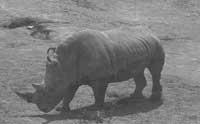
In general, some states that have traditionally been consumers of rhino branches (such as Japan, Hong Kong, Macau, Malaysia, Dubai, Burundi and the South African Republics), such as the International Convention on Traffic of Threatened Species (C.I.T.E.S. ). , which in recent years has prohibited and rejected the use of branches. But there are also Chinese with C.I.T.E.S. Those who leave the call and continue to consume this product, such as Korea, Taiwan and Thailand.
However, when adequate reserves have been created and they have been offered adequate protection against hunters, it has been observed that the proliferation of rhino populations is high. The examples are many. In the case of the black rhino we have just mentioned, in addition to avoiding destruction after the implantation of 11 special reserves, the population has been increased to reach the current 400 individuals.
The case of Nepal stands out. Although this is one of the poorest countries in the world, his government assumed responsibility in 1962 to protect rhinos by sending the army. As a result, the population of between 60 and 80 individuals has been multiplied to the current 400.
But the case of the southern white rhino is without lips the most spectacular. XIX. At the end of the twentieth century this subspecies was considered missing, but due to the protection policy established since 1920, it is the most common rhino present with about 4,800 individuals. In general, populations of Indian rhino, Kenyan black and Zaire white have been growing in recent years, while populations in South Africa have remained stable.
Rhino Pollation and Genetic Problem
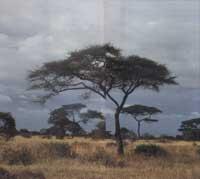
Unfortunately, there are still reasons to be pessimistic. In general, for most species, the populations are inferior to those considered as safe. On the one hand, the influence of natural disasters and diseases in small populations is more serious and, on the other, the significant decrease in the size of the populations is due to a genetic phenomenon called the bottleneck effect. This is so much because some characters are found only in individuals who die without proliferating, as each individual transmits only half of their genes each time they have a descendant, these populations lose their genetic variability.
Therefore, if the populations are very small, they bear the risk of losing an important part of their genetic variability, and if we take into account that the evolutionary potential of the species (that is, their response capacity evolving, evolving) depends on their genetic variability, it is evident that this problem is really serious. In addition, the problem is aggravated considering that the number of individuals who reproduce the population and thus transmit their genes is much lower than the total number.
Georgina Mace, of the Zoological Society of London, and Russel Lande, biologists of the University of Chicago, have calculated that the effective population (which reproduces) is 500 individuals to maintain rhinos in a safe state from the genetic point of view, to preserve 90% of their genetic variability within 100 years. If one takes into account that there is only one cash of five individuals, the total population should be 2,500 individuals and, in addition, to minimize the influence of natural disasters and pests, these populations should be divided into several subpopulations of at least 120 individuals.
Currently, the only species with this status is the white rhino, its southern subspecies. All other species have lower numbers and, in addition, rarely appear populations of 120 or more individuals, usually of less than 50 individuals and often of few individuals. The cases of the rhino of Sumatra and, above all, of Java are very worrisome, which in addition (with 60 individuals distributed in two cores) is in a critical situation.
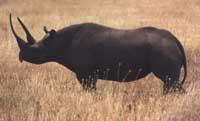
Therefore, the maintenance of the five current species and of all their races and subspecies (the two subspecies of the white rhino, the three races of the black and the other two of Sumatra) would require a population of 22,500 individuals, and if, as several biologists have stated, it is better to maintain almost that amount to guarantee total safety, it would have to quadruple the current population, facing another type of problems.
Population and habitat of rhino
One of the problems posed by the conservation of rhino is that of habitat. As mentioned, as they are such voluminous animals, they require a large surface environment in good condition, to be able to cover all their needs, and especially the obtaining of food.
So far, the important populations were in reserves or parks that provided them with an adequate habitat, and although the surface of these protected spaces was limited, due to the small size of the populations no problem has occurred. However, the population that can admit these spaces is limited, and although the majority of those who have maintained is below their optimum, they could not bear the growth of the above mentioned level, since by the time that time comes there are two possible solutions.
One of them, the most theoretically acceptable but difficult to carry into practice, is to bring the leftover individuals to new reserves. The contrary reasons are the difficulty to transport without any damage to rhinos, the difficulty to find suitable spaces and not altered by the human being and the great investments necessary to maintain them. The other, which can be simpler but unacceptable from a strict conservationist point of view, is to maintain the good size of the population through controlled hunting, so that with the sale of branches and the money that would be obtained in exchange for giving permission to hunters would be paid conservation expenses.

The debate has already begun. W. W. W. W. For the Kenyan government, the maximum defender of the orthodox approach of the F. Association, the only way to ensure the survival of rhino would be to prohibit hunting and selling products derived from rhino, being the main source of money necessary to create new reserves and to maintain the existing tourism attracted by rhino and other animals. The South Africans, especially the cinbabuanos, do not agree with this thesis. According to them, only with tourism can no one deal with the economic effort that conservation needs. Controlled hunting and trade in rhino branches would serve to obtain the necessary resources for their conservation, as well as to improve the standard of living of their people and, therefore, to warn of the benefit of their conservation.
At the moment, the central road is not possible (while hunting and trading of the rhinos of South Africa, banned in Kenya and other countries), since while the sale of the branches is legal and the demand of this product the secret hunters would have reason to continue hunting.
Meanwhile, time advances and, in some cases, the situation cannot be maintained for a long time. Therefore, if effective measures are not taken as soon as possible, one of these five species is considered to be destroyed.
CURRENT SITUATION OF RHINOS
- White rinocoronte Northern subspecies 28 individuals in 12 Czechoslovakia 2 USA 42 total Southern subspecies in South Africa 4,800
- Black rhino in 170 zoos 3,500 in Africa Kenya 400 Deer there are also 2,000 in Namibia and South Africa (about 1,100?)
- Indian rhino less than 2,000 in 400 India of Nepal
- Rhinoceros of Sumatra about 700
- Java rhino 60 approx. 12-15 Vietnam 50 approx. in Java
Although 170 species have been classified in the fossil record, there are currently only 5 species, all of them formed by the Rhinocerotidae family, belonging to the order of perisodactile mammals (horse and April).
Black rhinoceros ( Diceros bicornis )
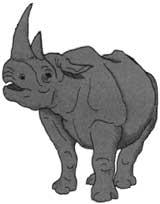
It lives in Africa, where the most important populations are in Kenya, Namibia, South Africa and Zinbabue. It lives in all habitats from mountains covered with tropical forests to dry areas covered with scrub. Its body has a length of 3 m and a maximum height of 1.6 m, with a weight of less than 2 tons. It is a chimaquero with an amasser digitiform appendix used to eat leaves and sinks in the upper lip. Survival is 40 years and pregnancy is 15 months.
White rhino ( Ceratotherium simun )
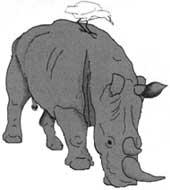
It is divided into two subspecies living in Africa. It lives in dry savannas and pastorea. The male can reach a body length of up to 4 m and a maximum height of 1.9 m, with a maximum weight of 2.3 t. The female is somewhat smaller and its weight is only 1.7 tons. Survival is 45 years and pregnancy is 16 months.
Indian rhinoceros ( Rhinoceros unicornis )
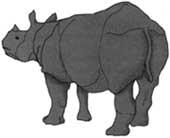
Lives in flat regions of India and Nepal. The male reaches a length of 3.8 m and a maximum height of 1.90 m, with a weight of 2.2 tons. The female is smaller and its weight is only 1.6 tons. It has a single branch and the bark presents appreciable folds that give it a shape of battleship. Little developed grass and appendix digitiform. Survival is 45 years and pregnancy is 16 months.
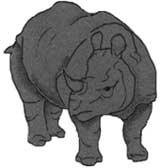
Java rhino ( Rhinoceros sondaicus )
It lives in Java and Vietnam in the tropical jungles of the plain. It is chemical and reaches a maximum weight of 1.4 tons. It has a single branch.
Rhinoceros of Sumatra ( Dicero hinus sumatrensis )
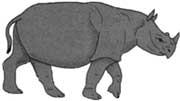
It lives in the mountainous tropical forests of southeast Asia and is chemical. The maximum length of the body is 3.15 m and the height is 1.38 m, with a weight of 800 kg. The skin is covered with a little hair. Survival is 32 years and pregnancy is 7-8 months.

Gai honi buruzko eduki gehiago
Elhuyarrek garatutako teknologia




